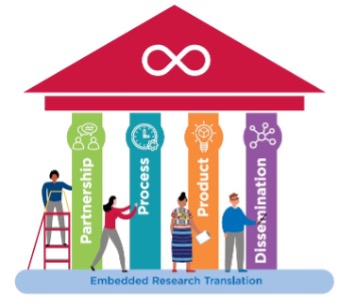Launch of Promising Practices for Embedded Research Translation
LASER PULSE is excited to present a new resource entitled Promising Practices for Embedded Research Translation: a toolkit to improve partnerships, processes, products, and dissemination. View the toolkit alongside our entire catalog of research translation resources at https://laserpulse.org/research-translation-tools-templates/.

This collection of 24 promising practices is a synthesis of the evidence and knowledge from 187 peer reviewed articles and practitioner reports. Through our analysis, we identified practices and tools that have led to positive outcomes in collaborative research translation projects. The purpose of the toolkit is to improve the capacity of researchers and practitioners to implement LASER PULSE’s Embedded Research Translation model.
Embedded Research Translation (ERT) is a new approach to research translation in international development, defined as an iterative co‑design process to intentionally apply research to development challenges. The toolkit is organized by the four pillars of the LASER PULSE’s Embedded Research Translation model: partnership, process, product, and dissemination. Each pillar is a separate chapter within the toolkit, further broken down into five sections: ERT definitions, evidence, promising practices, tools, and case studies. We recommend that these promising practices and tools are tailored to each project’s specific context.
 | Promising practices for Embedded Research Translation |
 | Promising practices to improve partnerships ● Involve diverse partners and stakeholders. ● Define the goal of the research translation together. ● Emphasize relationship building. ● Budget time for partnerships. ● Clarify assumptions, work cultures, and organizational structures. ● Share power. |
 | Promising practices to establish a collaborative process: ● Establish partnership structures, roles, and procedures. ● Plan for proactive engagement. ● Interactively frame the problem that research can address. ● Establish clear shared vocabulary and communication procedures. ● Co-design research translation as equal partners. ● Collectively plan for impact. |
 | Promising practices to create applicable products: ● Agree upon purpose, evidence, and product design early. ● Invest in understanding context. ● Engage with the audience early and often. ● Co-design research translation products. ● Decide how evidence will be represented. ● Develop several products to influence change. |
 | Promising practices to enhance dissemination: ● Co-design a dissemination plan early. ● Invest adequate time and resources in dissemination. ● Create a mixture of targeted dissemination approaches. ● Disseminate to a wide range of people and institutions. ● Monitor how evidence translates to impact. ● Build long-term trust and relationships for evidence uptake. |





Leave a Reply
You must be logged in to post a comment.